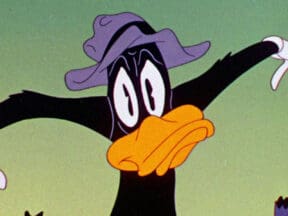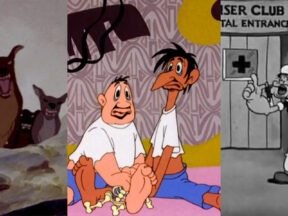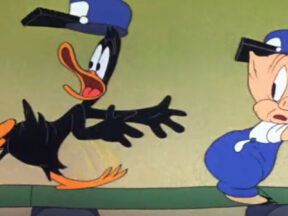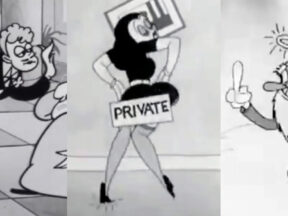
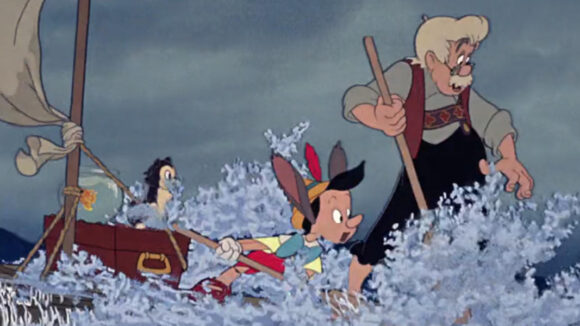
As Pixar’s ‘Elemental’ Hits Theaters, We Highlight Our Favorite Depictions Of Fire And Water In Animation
Pixar’s latest offering Elemental is a love story between water and fire. To celebrate its release, we’re taking a look at some of the best examples of water and fire animation throughout cartoon history.
Starting with the water effects: Disney’s Pinocchio (1940) contains what might be the greatest water animation ever drawn, thanks to the combined talents of effects artists Art Palmer, Josh Meador, Don Tobin, and Sandy Strother (Woolie Reitherman animated the whale). The mix of stunning realism and painterly abstraction in this 83-year-old sequence is nothing short of miraculous. You could only get a look like this in animation.
— Cartoon Study (@CartoonStudy) June 16, 2023
The realism that cgi artists are able to pull off is astounding. I remember seeing Finding Nemo (2003) as a kid and being blown away by how convincing the ocean looked.
— Cartoon Study (@CartoonStudy) June 16, 2023
That was 20 years ago, and the Pixar artists keep topping themselves. Piper (2016) boasts water so real it looks like you could reach out and touch it. Instead of using a preprogrammed aquatic pattern, the artists carefully shaped and timed each wave. To achieve this, tech supervisor Brett Levin took eyebrow models and transformed them into a shoreline. As director Alan Barillaro explained, “The water edge is literally 40 or 50 eyebrows moving back and forth. And the reason is that if we’re talking about comedy timing, it has to be exact to the frame.”
— Cartoon Study (@CartoonStudy) June 16, 2023
As amazing as those examples are, photorealism is just one of countless creative solutions to illustrating water; take for instance Aleksandr Petrov’s lovingly impressionistic paint-on-glass water in The Old Man and the Sea (1999).
— Cartoon Study (@CartoonStudy) June 16, 2023
Bill Nolan’s rubbery water in the Oswald the Lucky Rabbit cartoon The Singing Sap (1930) is about as far away from Pixar-style believability as you could get, and it’s wonderful. Nolan’s work absolutely revels in its cartoony unreality.
— Cartoon Study (@CartoonStudy) June 16, 2023
There’s a fantastic sea storm in the Ub Iwerks short Davy Jones’ Locker (1934), animated by Betty Boop creator Grim Natwick. This scene (reworked from 1932’s Stormy Seas) shows great imagination in transforming a frightening situation into a series of weird sight gags. I love the furiously squiggly drawings of the waves.
— Cartoon Study (@CartoonStudy) June 16, 2023
Hayao Miyazaki’s films are full of remarkable hand-drawn effects, with Ponyo (2008) being a prime example of the director’s poetic surrealism. There’s nothing logical about giant fish doubling as waves, but it makes perfect visual sense.
— Cartoon Study (@CartoonStudy) June 16, 2023
When it comes to memorable water sequences, it’s hard to top Fantasia (1940). According to art director Zack Schwartz, effects animator Ugo D’Orsi not only animated the water in this scene but also painted the cels, instead of handing it off to the ink & paint department. His meticulousness in detailing every drop gave his work a foamy “popcorn” effect.
— Cartoon Study (@CartoonStudy) June 16, 2023
I still remember being six years old and seeing the parting of the Red Sea from The Prince of Egypt (1998) on the big screen. Technology has come a long way since then, but this early cg effect is as sublime and powerful as ever.
— Cartoon Study (@CartoonStudy) June 16, 2023
We tend to associate cg animation with realism, but that’s certainly not intrinsic to the medium. The ocean in Phil Lord and Christopher Miller’s The Lego Movie (2014) is cleverly designed and animated to match the film’s whimsical worldbuilding.
— Cartoon Study (@CartoonStudy) June 16, 2023
Sometimes studios will create 2d pencil tests to work out a final 3d aesthetic. Eric Goldberg did a test animation of the magical living ocean in Moana (2016), which served as a guide for the finished film. Here’s a side-by-side comparison.
— Cartoon Study (@CartoonStudy) June 16, 2023
The hand-drawn ripples and splashes in William Salazar’s Bird Karma (2018) are detailed without losing their spontaneity. The visual style here, designed by Raymond Zibach, was inspired by painter J. M. W. Turner.
— Cartoon Study (@CartoonStudy) June 16, 2023
In Charlie Brown’s All Stars! (1966), waves are reduced to scribbles. I love this approach; it’s simple, direct, and loaded with personality.
— Cartoon Study (@CartoonStudy) June 16, 2023
One of the most heavily abstracted sea storms appears in the UPA cartoon Fudget’s Budget (1954), designed by T. Hee and Jules Engel. Every single aspect of this – the waves, the rain, the lightning – is put across in boldly offbeat fashion.
— Cartoon Study (@CartoonStudy) June 16, 2023
Another ultra-stylized ocean shows up in Dušan Vukotić’s ingenious Ersatz (1961). I love the way the water is just one unmoving painting, while perfectly geometric lines and loops are drawn on top to suggest drips and splashes.
— Cartoon Study (@CartoonStudy) June 16, 2023
I’m fascinated by artists who are able to strip things down to bare essentials. There isn’t much detail in The Animal Movie (1966), directed by Grant Munro and Ron Tunis, but the few lines and splashes of color that are here perfectly aid the storytelling.
— Cartoon Study (@CartoonStudy) June 16, 2023
A lot of modern stop-motion films use cg for water scenes, which is kind of a shame because I like to see how they pull off those sorts of effects within the medium. Is there anything better than those quirky ripples in the Rankin-Bass special Rudolph the Red-Nosed Reindeer (1964)?
— Cartoon Study (@CartoonStudy) June 16, 2023
In Hayley Morris’ heartbreaking short Undone (2008), the water resembles a rolling blanket. The tangible textures give the film a personal touch.
— Cartoon Study (@CartoonStudy) June 16, 2023
The herky-jerky water is just as kooky as everything else in the underrated French feature A Town Called Panic (2009). Every moment in this film is overflowing with gleeful invention.
— Cartoon Study (@CartoonStudy) June 16, 2023
Roaring waters never looked as soothing as they do in the hands of Andrea Love, who animates using needle-felted wool. Whether animating syrup, bubbles, or pencil shavings, her work is always mesmerizing.
— Cartoon Study (@CartoonStudy) June 16, 2023
Turning our attention to fire, we have one of the all-time great effects sequences: the forest fire in Disney’s Bambi (1942). Designer Tyrus Wong’s bold color choices turn an already exciting scene into a terrifying nightmare as Bambi’s home is transformed into a hellish inferno by careless humans. The fire in the sky at the end of this clip was created by photographing a shiny metallic sheet, which reflected and distorted the animation drawings and created a warping effect. This same process was used for the ghosts in Fantasia.
— Cartoon Study (@CartoonStudy) June 16, 2023
I particularly love fire animation with visible brushwork. There’s some great use of dry brush in the climax of Max Fleischer’s Superman (1941), the first cinematic depiction of the popular superhero, in which flames spurt out of a doomsday machine.
— Cartoon Study (@CartoonStudy) June 16, 2023
Anthropomorphized fire is a longstanding tradition in animation, from fiery villains to mischievous little flames who run away from cartoon firemen. The battle with the Fire God in Yūgo Serikawa’s The Little Prince and the Eight-Headed Dragon (1963) is an excellent fight sequence and a 2d effects tour de force. This seminal early anime feature went on to influence the look of the tv series Samurai Jack.
— Cartoon Study (@CartoonStudy) June 16, 2023
A more friendly personified flame is the fire demon Calcifer, who steals the show in Hayao Miyazaki’s Howl’s Moving Castle (2004). It’s particularly impressive the way the animators are able to give Calcifer an appealing personality without sacrificing the illusion that he’s a smoldering flame.
— Cartoon Study (@CartoonStudy) June 16, 2023
Four elements (water, earth, fire, and air) are used instead of weaponry for the battle scenes in Avatar: The Last Airbender. Creators Bryan Konietzko and Michael Dante DiMartino gave each of the four nations a different Kung Fu fighting style, with the aggressive Northern Shaolin style serving as the inspiration for firebending.
— Cartoon Study (@CartoonStudy) June 16, 2023
Great animation can turn the familiar on its head. We all know what fire looks like, but the green coloring and ornately-rendered swirls of the dragon’s breath in Disney’s Sleeping Beauty (1959) are something new. Brilliant design work by Eyvind Earle here.
— Cartoon Study (@CartoonStudy) June 16, 2023
In contrast to the intricate artwork in Sleeping Beauty, the fire in Noémie Marsily & Carl Roosens’ I Don’t Feel Anything Anymore (2016) is delightfully loose, like a New Yorker gag cartoon set in motion.
— Cartoon Study (@CartoonStudy) June 16, 2023
Veering away from traditional drawn animation entirely, Polish animator Witold Giersz uses a thick application of oil paint to show us a haunting depiction of a forest fire in his short film Pożar (1975).
— Cartoon Study (@CartoonStudy) June 16, 2023
Creating fire in stop-motion isn’t easy; many films either use cg or set the puppets on fire in real time (which is fun). Still, it’s nice to see stop-motion fire when someone pulls it off. The 1980s Welsh series Fireman Sam used paper cutouts and colored lights to suggest fire.
— Cartoon Study (@CartoonStudy) June 16, 2023
I love the approach to fire in the Julien Baker music video Hardline (2021), directed by Joe Baughman, which is intentionally artificial and charmingly hand-crafted.
— Cartoon Study (@CartoonStudy) June 16, 2023
As much as I love elaborate effects, it’s just as inspiring to see details sidestepped in a clever and disarmingly simple fashion, like this Yule Log from animator PES.
— Cartoon Study (@CartoonStudy) June 16, 2023
Well, that’s it for now. What are your favorite fire or water effects in animation? Let us know in the comments below. Good luck braving the elements!
— Cartoon Study (@CartoonStudy) June 16, 2023
Pictured at top: Pinocchio

.png)
